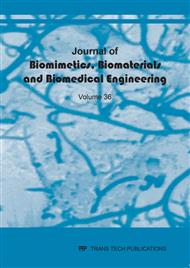[1]
Bratu D, Nussbaum R: Clinical and technical basis of fixed prosthesis, Medical Publishing House, Bucuresti, (2007).
Google Scholar
[2]
Combe E C, Owen B A, Hodges J S: A protocol for determining the surface free energy of dental materials. Dent Mater. 20 (2004) 262–268.
DOI: 10.1016/s0109-5641(03)00102-7
Google Scholar
[3]
Rossi A De, Albuquerque R F Jr, Bezzon O L: Esthetic options for the fabrication of removable partial dentures: A clinical report. J Prosthet Dent. 86 (2001) 465-467.
DOI: 10.1067/mpr.2001.119678
Google Scholar
[4]
Donovan T E, Cho G C: Esthetic considerations with removable partial dentures. J Calif Dent Assoc. 3 (2003) 551-557.
DOI: 10.1080/19424396.2003.12224200
Google Scholar
[5]
Ucar Y, Akova T, Aysan I: Mechanical Properties of Polyamide versus Different PMMA. J Prosthodont 21 (2012) 173–176.
DOI: 10.1111/j.1532-849x.2011.00804.x
Google Scholar
[6]
Rickman L J, Padipatvuthikul P, Satterthwaite J D: Contemporary denture base resins: Part 2, Dent Update 39 (2012) 176–178.
DOI: 10.12968/denu.2012.39.3.176
Google Scholar
[7]
Donovan T E, Chee W W: A review of contemporary impression materials and techniques. Dent Clin North Am 48 (2004) 445-470.
Google Scholar
[8]
Kotsiomiti E, Tzialla A, Hatjivasiliou K: Accuracy and stability of impression materials subjected to chemical disinfection: A literature review, J Oral Rehabil 35 (2008) 291-299.
DOI: 10.1111/j.1365-2842.2007.01771.x
Google Scholar
[9]
Wang L, Perlatti D'Alpino P H, Gonzaga Lopes L, Pereira J C: Propriedades mecânicas dos materiais dentários restauradores:contribuição relativa dos ensaios laboratoriais. J Appl Oral Sci 11 (2003) 162-167.
Google Scholar
[10]
Gratton D G, Aquilino S A: Interim restorations. Dent Clin North Am 48, (2004) 487-497.
DOI: 10.1016/j.cden.2003.12.007
Google Scholar
[11]
Asmussen E, Peutzfeldt A, Sahafi A: Finite element analysis of stresses in endodonti- cally treated, dowel-restored teeth. J Prosthet Dent 94 (2005) 321-329.
DOI: 10.1016/j.prosdent.2005.07.003
Google Scholar
[12]
Hamanaka I, Takahashi Y, Shimizu H: Mechanical properties of injection-molded thermoplastic denture base resins. Acta Odonto Scand 69 (2011) 75–79.
DOI: 10.3109/00016357.2010.517557
Google Scholar
[13]
John J, Gangadhar S A, Shah I: Flexural strength of heat polymerized polymethyl methacrylate denture resin reinforced with glass, aramid, or nylon fibers. J Prosthet Dent 86 (2001) 424–427.
DOI: 10.1067/mpr.2001.118564
Google Scholar
[14]
Michalakis K, Pissiotis A, Hirayama H, Kang K, Kafantaris N: Comparison of temperature increase in the pulp chamber during the polymerization of materials used for the direct fabrication of provisional restorations. J Prosthet Dent 96 (2006).
DOI: 10.1016/j.prosdent.2006.10.005
Google Scholar
[15]
Ebadian B, Rismanchian M, Dastgheib B, Bajoghli F: Effect of different impression materials and techniques on the dimensional accuracy of implant definitive casts. Dent Res J 12 (2015) 136-143.
Google Scholar
[16]
Rubel B S: A Comparative Review of Impression Materials Most Commonly Used in Restorative Dentistry. Dent Clin North Am 51 (2007) 629-642.
DOI: 10.1016/j.cden.2007.03.006
Google Scholar
[17]
Samra RK, Bhide SV. Efficacy of different disinfectant systems on alginate and additional silicone impression materials of Indian and International origin: A Comparative study. J Indian Prosthodont Soc. 10 (2010) 182–9.
DOI: 10.1007/s13191-010-0040-y
Google Scholar
[18]
T. A. Hamalian, E. Nasr, and J. J. Chidiac, Impression materials in fixed prosthodontics: influence of choice on clinical procedure,, Journal of Prosthodontics 20 (2011) 153–160.
DOI: 10.1111/j.1532-849x.2010.00673.x
Google Scholar
[19]
U. Nassar, A. Oko, S. Adeeb, M. El-Rich, and C. Flores-Mir, An in vitro study on the dimensional stability of a vinyl polyether silicone impression material over a prolonged storage period,, Journal of Prosthetic Dentistry 109 (2013) 172–178.
DOI: 10.1016/s0022-3913(13)60038-4
Google Scholar


